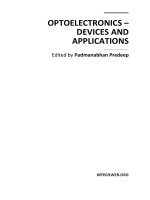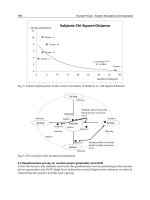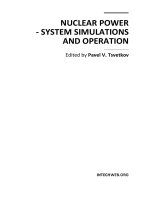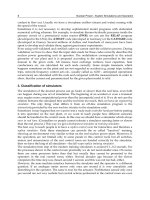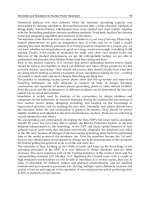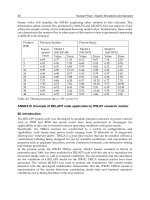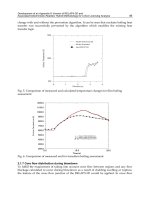Nuclear Power System Simulations and Operation Part 1 pdf
Bạn đang xem bản rút gọn của tài liệu. Xem và tải ngay bản đầy đủ của tài liệu tại đây (363.92 KB, 15 trang )
NUCLEAR POWER
- SYSTEM SIMULATIONS
AND OPERATION
Edited by Pavel V. Tsvetkov
Nuclear Power - System Simulations and Operation
Edited by Pavel V. Tsvetkov
Published by InTech
Janeza Trdine 9, 51000 Rijeka, Croatia
Copyright © 2011 InTech
All chapters are Open Access articles distributed under the Creative Commons
Non Commercial Share Alike Attribution 3.0 license, which permits to copy,
distribute, transmit, and adapt the work in any medium, so long as the original
work is properly cited. After this work has been published by InTech, authors
have the right to republish it, in whole or part, in any publication of which they
are the author, and to make other personal use of the work. Any republication,
referencing or personal use of the work must explicitly identify the original source.
Statements and opinions expressed in the chapters are these of the individual contributors
and not necessarily those of the editors or publisher. No responsibility is accepted
for the accuracy of information contained in the published articles. The publisher
assumes no responsibility for any damage or injury to persons or property arising out
of the use of any materials, instructions, methods or ideas contained in the book.
Publishing Process Manager Petra Zobic
Technical Editor Teodora Smiljanic
Cover Designer Jan Hyrat
Image Copyright fuyu liu, 2010. Used under license from Shutterstock.com
First published July, 2011
Printed in Croatia
A free online edition of this book is available at www.intechopen.com
Additional hard copies can be obtained from
Nuclear Power - System Simulations and Operation, Edited by Pavel V. Tsvetkov
p. cm.
ISBN 978-953-307-506-8
Contents
Preface IX
Chapter 1 Simulation and Simulators for Nuclear Power Generation 1
Janos Sebestyen Janosy
Chapter 2 Safety Studies and General Simulations
of Research Reactors Using Nuclear Codes 21
Antonella L. Costa, Patrícia A. L. Reis, Clarysson A. M. Silva,
Claubia Pereira, Maria Auxiliadora F. Veloso, Bruno T. Guerra,
Humberto V. Soares and Amir Z. Mesquita
Chapter 3 Development of an Appendix K Version of
RELAP5-3D and Associated Deterministic-Realistic
Hybrid Methodology for LOCA Licensing Analysis 43
Thomas K. S. Liang
Chapter 4 Analysis of Error Propagation
Between Software Processes 69
Sizarta Sarshar
Chapter 5 Thermal-Hydraulic Analysis
in Support of Plant Operation 87
Francesc Reventós
Chapter 6 A Literature Survey of Neutronics and Thermal-Hydraulics
Codes for Investigating Reactor Core Parameters; Artificial
Neural Networks as the VVER-1000 Core Predictor 103
Farshad Faghihi H. Khalafi and S. M. Mirvakili
Chapter 7 Recent Trends in Mathematical
Modeling and Simulation of Fission Product
Transport From Fuel to Primary Coolant of PWRs 123
Nasir M. Mirza, Sikander M. Mirza and Muhammad J. Iqbal
Chapter 8 Thermal-Hydraulic Simulation of
Supercritical-Water-Cooled Reactors 139
Markku Hänninen and Joona Kurki
VI Contents
Chapter 9 Non-Linear Design Evaluation of
Class 1-3 Nuclear Power Piping 153
Lingfu Zeng, Lennart G. Jansson and Lars Dahlström
Chapter 10 The Text-Mining Approach Towards
Risk Communication in Environmental Science 175
Akihide Kugo
Preface
At the onset of the 21
st
century, we are searching for reliable and sustainable energy
sources that have a potential to support growing economies developing at accelerated
growth rates, technology advances improving quality of life and becoming available to
larger and larger populations. We have to make sure that this continuous quest for
prosperity does not backfire via catastrophic irreversible climate changes, and
depleted or limited resources that may challenge very existence of future generations.
We are at the point in our history when we have to make sure that our growth is
sustainable. New energy sources and systems must be inherently safe and
environmentally benign.
The quest for robust sustainable energy supplies meeting the above constraints leads
us to the nuclear power technology. Today’s nuclear reactors are safe and highly
efficient energy systems that offer electricity and a multitude of co-generation energy
products ranging from potable water to heat for industrial applications. Although it is
not inherently sustainable as solar power, nuclear technology is sustainable by design.
Advanced nuclear energy systems are capable to breed new fuel, take care of nuclear
waste and operate in an inherently safe way with minimized environmental effects.
Catastrophic earthquake and tsunami events in Japan resulted in the nuclear accident
that forced us to rethink our approach to nuclear safety, requirements and facilitated
growing interests in designs, which can withstand natural disasters and avoid
catastrophic consequences.
This book is one in a series of books on nuclear power published by InTech. It consists
of ten chapters on system simulations and operational aspects:
• Simulation and Simulators used for Nuclear Power Generation,
• Safety Studies and General Simulations of Research Reactors Using Nuclear
Codes,
• Development of an Appendix K Version of RELAP5-3D and Associated
Deterministic-Realistic Hybrid Methodology for LOCA Licensing Analysis,
• Analysis of Error Rropagation Between Software Processes,
• Thermal-hydraulic Analysis in Support of Plant Operation,
• A Literature Survey of Neutronic and Thermal-Hydraulics Codes for
Investigating Reactor Core Parameters; Artificial Neural Networks as the VVER-
1000 Core Predictor,
X Preface
• Recent Trends in Mathematical Modeling & Simulation of Fission Product
Transport from Fuel to Primary Coolant of PWRs,
• Thermal-hydraulic Simulations of Supercritical-water-cooled Reactors,
• Non-linear Design Evaluation of Class 1-3 Nuclear Power Piping,
• The Method of Text-mining Approach Towards Risk Communication in
Environmental Science.
Our book does not aim at a complete coverage or a broad range. Instead, the included
chapters shine light at existing challenges, solutions and approaches. Authors hope to
share ideas and findings so that new ideas and directions can potentially be developed
focusing on operational characteristics of nuclear power plants. The consistent thread
throughout all chapters is the “system-thinking” approach synthesizing provided
information and ideas.
The book targets everyone with interests in system simulations and nuclear power
operational aspects as its potential readership groups - students, researchers and
practitioners. The idea is to facilitate intellectual cross-fertilization between field
experts and non-field experts taking advantage of methods and tools developed by
both groups. The book will hopefully inspire future research and development efforts,
innovation by stimulating ideas.
We hope our readers will enjoy the book and will find it both interesting and useful.
Pavel V. Tsvetkov
Department of Nuclear Engineering
Texas A&M University
United States of America


